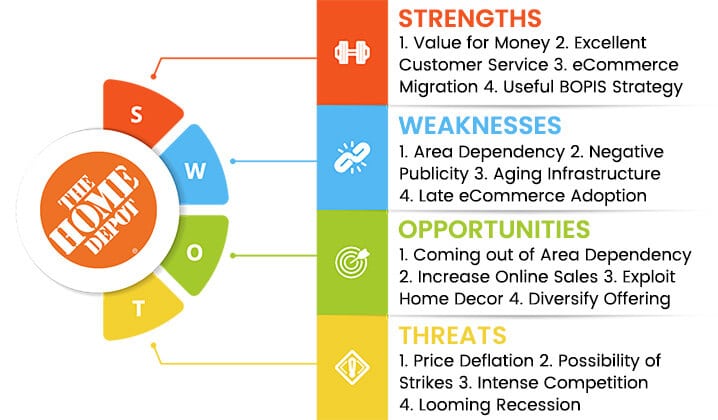Home Depot has been revolutionizing the home improvement sector for the last 40 years. It has risen gradually by being a do-it-yourself marketplace. A Home Depot SWOT analysis will help us determine what strengths and weaknesses have helped them become the second-largest home improvement shopping store that owns sales of +/- 100 billion dollars. This company has been a shining example of rising from nothing.
Home Depot: At A Glance
| Company Name | The Home Depot |
| Industry | Retailing |
| Founded | February 6, 1978 |
| Founders | Bernard Marcus, Arthur Blank, Ron Brill, Pat Farrah, Kenneth Langone |
| CEO | Craig Menear |
| Headquarter | Atlanta, Georgia, United States |
| Annual Revenue | $110.2 Billion (FY 2019) |
| Website | www.homedepot.com |
Table of Contents
Home Depot SWOT Analysis
A SWOT analysis will assist in determining the company’s current position as well as assessing its business prospects and determining its future growth.
- You May Like: Walmart SWOT Analysis
Strengths of SWOT Analysis of Home Depot
First off in the Home Depot SWOT analysis chart, we should analyze Home Depot’s strengths:
Value for money: Home Depot always offers the best service at a very affordable price. Everyone wants a worthy run for their money. Every time customers come to a retail shop, they’ll compare the prices of similar products. Home Depot always wins the competition by 10%.
One-stop solution: Home Depot is the one-stop solution for the widest variety of products. You can find anything here, from furniture to tools, kitchen apparatus to construction materials, and all kinds of home appliances under one roof.
Excellent Customer Service: Home Depot has a great track record of treating customers with the respect they deserve. They have practiced the culture of excellent customer service for some time and always strive to improve the shopper’s experience.
Useful BOPIS Strategy: Home Depot has an efficient and exclusive buy-online, pick-up-in-store service. This brings them almost 40% of online orders. The effectiveness of Home Depot’s exclusive BOPIS strategy has been really beneficial to their growth.
eCommerce migration: During the COVID pandemic, Home Depot effectively migrated into their online services. The sales that stood at 1% in 2010 and around 6% in 2019 now contribute more than 30% of the sales.
Home Depot SWOT Analysis Weaknesses

The weaknesses or areas to be improved are discussed next in this Home Depot SWOT analysis.
Area Dependency: Among the total of 2200 stores owned by Home Depot, all of them are mostly located in North America. The exceptional locations are 180 stores in Canada and 125 in Mexico. The markets in Canada and the U.S. are having great sales, whereas the Mexican market is quite unstable. If Home Depot were less dependent on North American locations, their revenues could be higher than they already are.
Aging Infrastructure: The Home Depot is over 40 years old. Fairly possible that it has an older infrastructure. But this old infrastructure is causing Home Depot a great deal of business harm. The old Home Depot invested over $11 billion for digital transformation only for the project to fail because of the crumbling infrastructure.
Negative Publicity: Some administrative decisions of Home Depot have caused a negative impression among the mass media. In 2019, Home Depot fired an employee after he requested a disability-related emergency break. The company was forced to pay 100 thousand dollars to settle the case. Even though the settlement happened, this issue caused a big negative impact on the company’s reputation.
Late eCommerce Adoption: Home Depot has adapted its e-commerce sales with the pandemic and lockdown hit. But they could’ve entered sooner in the online section. Now they’re not as dominant in e-commerce sales as they are in physical stores. This appears to be a Home Depot weakness.
Home Depot SWOT Analysis Opportunities
A Home Depot SWOT analysis offers the brightest part of the opportunities:
Increase Online Sales: During the COVID-19 pandemic, Home Depot has effectively migrated into its online services. The sales that stood at 1% in 2010 and around 6% in 2019 now contribute more than 30% of the sales. Its recent online push has given the company an edge over competitors like Lowe’s. This shows it has immense potential for growth if it increases online sales.
Capitalize on Home Decor: With key players such as Bed, Bath, and Beyond facing multiple challenges of their own, the home decor section has much growth potential. After Home Depot acquired The Company Store, it has come to a position where its opponents’ misfortune will result in its profit if handled expertly.
Expand via Partnerships: Home Depot has expanded its market to China. But after it failed to attract enough customers, it was forced to retreat. To make its expansion more successful, it can work alongside companies that understand the local market better, namely the local home improvement retailers.
Grow through Acquisitions: It will be much easier for Home Depot to grow through acquisitions. By acquiring Bed Bath and Beyond, Home Depot can easily enter the home decor section of the market and at the same time catalyze its growth. In 2023 Bed Bath and Beyond began to fall and may not be a good acquisition based on this Home Depot SWOT Analysis.
Diversify Offering: despite home improvement being Home Depot’s sole focus for many years, it could start dividing its attention to the food retail section and/or apparel.
Threats for Home Depot in SWOT Analysis

Each SWOT analysis that has been considered helpful comes with an extraordinary perspective for threat concerns.
Intense Competition: In terms of swiftly closing the gap that Home Depot has spent a fair amount of time building, Lowe’s is one of the tops of the list that Home Depot has to keep an eye on. On that note, Amazon is also a major threat to Home Depot’s market share.
Looming Recession: In these economically challenging times, major-scale construction and house improvements have been either postponed or toned down. With the unwanted recession rearing its ugly head in the aftermath of this deadly pandemic, Home Depot’s increasing profits have a fair chance to end. This Home Depot analysis highlights how the economic challenges have hit the competition hard.
Price deflation: Over the past two years, the cost of lumbar has significantly impacted Home Depot. All because lumber accounts for 18% of its total revenue. The company has failed to meet the expectations that have been placed on its shoulders after this devastating turn of events.
Possibility of Strikes: The bargaining power of employees has been significantly increased by adopting the UMSCA. Even at this moment, Mexican Home Depot employees demand a 20% pay raise to match their Northern colleagues.
Home Depot SWOT Analysis Overview Template

Conclusion and Recommendations for Home Depot
In summary, this Home Depot SWOT analysis shows their strategy for market success is based on a combination of customer understanding, operational excellence, and customer satisfaction. To provide more convenience and at less cost than its competitors, Home Depot relies on its excellent operating system.
Home Depot focuses on its stores, advertisements, and IT systems to enable its e-commerce system to be automated.
- Continue growth through solving legal problems that caused a negative reputation
- Pursue growth through alliances and partnerships
- Growing revenue with a better reputation through new infrastructure building
With this Home Depot SWOT analysis, the company highlighted each of the strengths, weaknesses, opportunities, and threats of Home Depot on the market. To increase its market share and financial stability, Home Depot must take vigorous action.
FAQs for Home Depot Analysis
1. What are some weaknesses of Home Depot?
Home Depot, despite its size, faces certain weaknesses, like a limited international presence, which restricts global growth. Additionally, the company’s heavy reliance on the U.S. market makes it vulnerable to domestic economic fluctuations.
2. What are the strengths of The Home Depot company?
Home Depot boasts a strong brand reputation, an extensive product range, and efficient supply chain management. It is a market leader in the retail home improvement industry as a result of these strengths and a dedicated focus on customer service.
3. How does Home Depot differentiate itself?
Home Depot differentiates itself through a unique blend of wide-ranging, high-quality products and exceptional customer service. It also emphasizes on providing expert advice and DIY workshops, fostering a community-centric approach that appeals to both professional contractors and home improvement enthusiasts.
However, in spite of the negative factors, it is without a doubt a symbol of progress and innovation.





